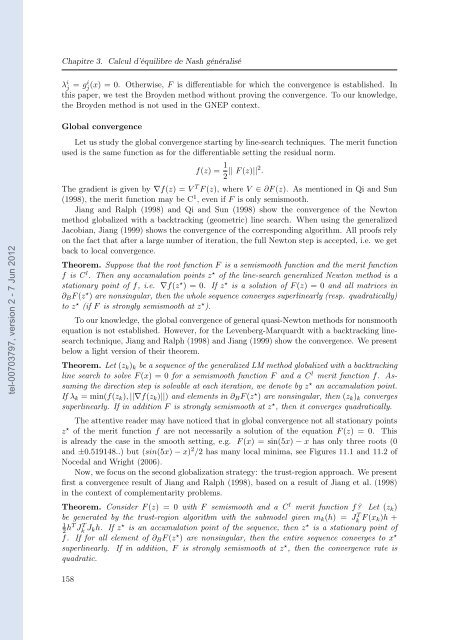Etude des marchés d'assurance non-vie à l'aide d'équilibres de ...
Etude des marchés d'assurance non-vie à l'aide d'équilibres de ...
Etude des marchés d'assurance non-vie à l'aide d'équilibres de ...
Create successful ePaper yourself
Turn your PDF publications into a flip-book with our unique Google optimized e-Paper software.
tel-00703797, version 2 - 7 Jun 2012<br />
Chapitre 3. Calcul d’équilibre <strong>de</strong> Nash généralisé<br />
λi j = gi j (x) = 0. Otherwise, F is differentiable for which the convergence is established. In<br />
this paper, we test the Broy<strong>de</strong>n method without proving the convergence. To our knowledge,<br />
the Broy<strong>de</strong>n method is not used in the GNEP context.<br />
Global convergence<br />
Let us study the global convergence starting by line-search techniques. The merit function<br />
used is the same function as for the differentiable setting the residual norm.<br />
f(z) = 1<br />
2 || F (z)||2 .<br />
The gradient is given by ∇f(z) = V T F (z), where V ∈ ∂F (z). As mentioned in Qi and Sun<br />
(1998), the merit function may be C 1 , even if F is only semismooth.<br />
Jiang and Ralph (1998) and Qi and Sun (1998) show the convergence of the Newton<br />
method globalized with a backtracking (geometric) line search. When using the generalized<br />
Jacobian, Jiang (1999) shows the convergence of the corresponding algorithm. All proofs rely<br />
on the fact that after a large number of iteration, the full Newton step is accepted, i.e. we get<br />
back to local convergence.<br />
Theorem. Suppose that the root function F is a semismooth function and the merit function<br />
f is C 1 . Then any accumulation points z ⋆ of the line-search generalized Newton method is a<br />
stationary point of f, i.e. ∇f(z ⋆ ) = 0. If z ⋆ is a solution of F (z) = 0 and all matrices in<br />
∂BF (z ⋆ ) are <strong>non</strong>singular, then the whole sequence converges superlinearly (resp. quadratically)<br />
to z ⋆ (if F is strongly semismooth at z ⋆ ).<br />
To our knowledge, the global convergence of general quasi-Newton methods for <strong>non</strong>smooth<br />
equation is not established. However, for the Levenberg-Marquardt with a backtracking linesearch<br />
technique, Jiang and Ralph (1998) and Jiang (1999) show the convergence. We present<br />
below a light version of their theorem.<br />
Theorem. Let (zk)k be a sequence of the generalized LM method globalized with a backtracking<br />
line search to solve F (x) = 0 for a semismooth function F and a C 1 merit function f. Assuming<br />
the direction step is solvable at each iteration, we <strong>de</strong>note by z ⋆ an accumulation point.<br />
If λk = min(f(zk), ||∇f(zk)||) and elements in ∂BF (z ⋆ ) are <strong>non</strong>singular, then (zk)k converges<br />
superlinearly. If in addition F is strongly semismooth at z ⋆ , then it converges quadratically.<br />
The attentive rea<strong>de</strong>r may have noticed that in global convergence not all stationary points<br />
z ⋆ of the merit function f are not necessarily a solution of the equation F (z) = 0. This<br />
is already the case in the smooth setting, e.g. F (x) = sin(5x) − x has only three roots (0<br />
and ±0.519148..) but (sin(5x) − x) 2 /2 has many local minima, see Figures 11.1 and 11.2 of<br />
Nocedal and Wright (2006).<br />
Now, we focus on the second globalization strategy: the trust-region approach. We present<br />
first a convergence result of Jiang and Ralph (1998), based on a result of Jiang et al. (1998)<br />
in the context of complementarity problems.<br />
Theorem. Consi<strong>de</strong>r F (z) = 0 with F semismooth and a C 1 merit function f? Let (zk)<br />
be generated by the trust-region algorithm with the submo<strong>de</strong>l given mk(h) = J T k F (xk)h +<br />
1<br />
2 hT J T k Jkh. If z ⋆ is an accumulation point of the sequence, then z ⋆ is a stationary point of<br />
f. If for all element of ∂BF (z ⋆ ) are <strong>non</strong>singular, then the entire sequence converges to x ⋆<br />
superlinearly. If in addition, F is strongly semismooth at z ⋆ , then the convergence rate is<br />
quadratic.<br />
158
















